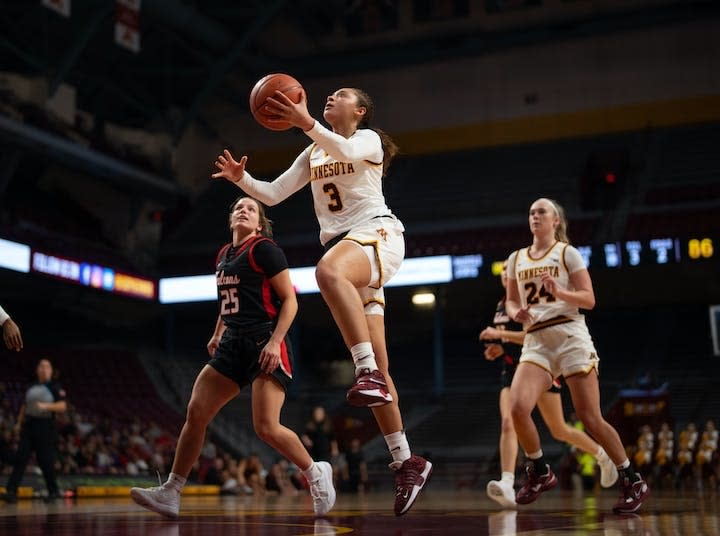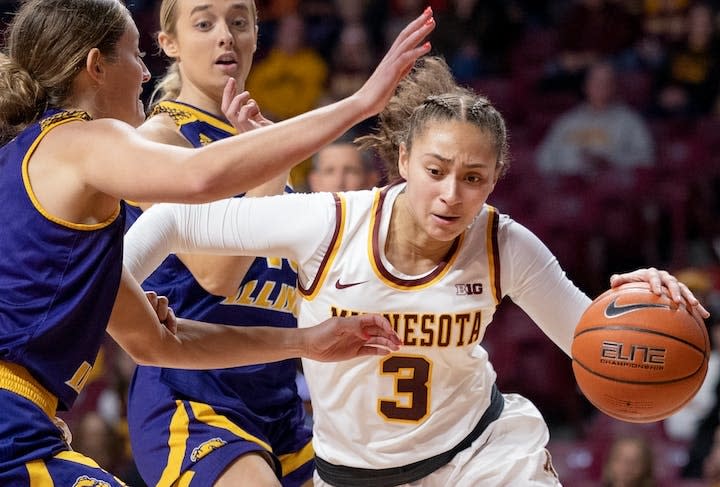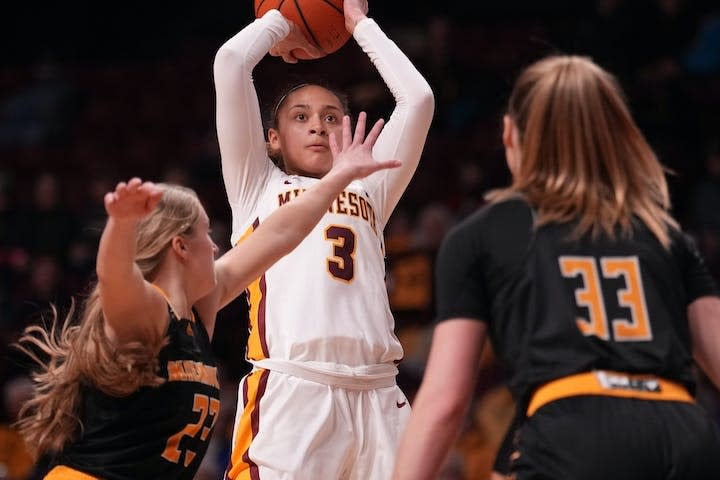Battle wants to lead the Gophers — but first she had to fix her shot
Amaya Battle knew what the problem was. It wasn't like she needed to sit down, watch tape, ponder, try to figure out.
It wasn't a head-scratcher, but her shot was.
"I hated watching it on film," Battle said.
Head-scratcher. Those are Battle's words, the way she describes her shot from last season, her freshman year with the Gophers.
She would bring her shooting hand way, way back behind her head, her form looking more like a shot put than a typical jump shot. And, frankly, Battle — who didn't shoot like that as a high school star at Hopkins — isn't exactly sure how it happened. Her best guess:
"I always thought I wasn't strong enough from the three-point line," she said. "And you come to college and it's moved back. So I always wanted to get that extra push. So maybe that's where the shot put thing came into it. But that's long gone now."
Battle has changed her shot.
It is the process of hours in the gym, a regimen that started very quickly after last season ended, well before Dawn Plitzuweit had been hired as head coach. It is the result of hundreds of hours spent in the gym trying to re-wire her muscle memory, working with several people, including teammate Mara Braun and assistant coach Rachel Banham, who had one of the prettiest shots in Gophers history.
Limiting turnovers
Battle is about to enter her second season as the Gophers point guard. Last year, she appeared in all 30 games, starting 24. Her 133 assists were the most ever by a Minnesota freshman. Her 4.4 assists per game led the team and ranked eighth in the Big Ten, first among conference freshmen.
She was tied for first on the team with 22 blocks, third on the team in rebounding (5.9) and fourth in scoring (9.0).
She also led the team with 3.8 turnovers per game.
Sign up for our Gophers Update newsletter
There are a few reasons for this. The 5-11 Battle is a strong, assertive driver to the hoop. Early in her first season, she made a habit of blowing past opponents into the paint, where she either finished at the rim — her ability to finish through contact was immediately impressive — or got the ball to an open teammate. She had a season-high nine assists in her first game, a non-conference victory over Western Illinois. In her second game, against Lehigh, Battle scored 17 points, had nine rebounds and made the pass to Braun for her buzzer-beating three in a 101-99 victory. In her first Big Ten game, Battle scored 19 points with five boards and five assists in a double-OT victory over Penn State.
But as the season went on, teams adjusted. Battle was a 39% shooter last season. Teams began playing off of her, daring her to shoot, making drives to the basket more difficult.
"Teams started sagging on me," she said. "Going under screens, packing the lane on me."
Sometimes Battle tried to force things, like driving into a packed lane. Or trying to force the ball inside. The result was too many turnovers.
Battle's biggest goal is to keep distributing the ball at a high level while cutting down on turnovers. Maybe the best way to do that is to shoot better.
"She has to be a threat for us," Plitzuweit said. "When Amaya is aggressive, in terms of looking to score first, we as a team are better. And she's better."
Battle knows this. Proving she can hit a three will force defenses up, creating space. Showing she can consistently create her own mid-range shot will open things up for everyone else. It's been her focus for months now.
Branching out
Plitzuweit and Battle have talked about the process. It starts with taking shots on your own, missing too many at first, then making more. "Then you have to take them in practice, missing them in practice, then start making them in practice," Battle said.
And then you do the same in games, which start in a few weeks. "Knowing there is a process, seeing yourself grow in each step … I've done the on-my-own part and the in-practice part. I've had plenty of help."
Will it translate to games? Bet on it. Battle is making a habit of accomplishing things.
She came to school planning to get into sports psychology. And she still might. But she's been intrigued by media; she is a photographer for the Minnesota Daily and hosts the Gold-Blooded podcast, which is produced in-house and available on YouTube. She still has dreams of playing pro ball in the WNBA, but the team's summer trip to Croatia and Greece sparked the idea of playing overseas, traveling, learning new cultures.
For right now, she wants to help the Gophers win. "That just means being relentless on offense and defense," she said. "Being fearless when it comes to taking the shot, being intentional to get your teammates open as well."




